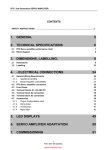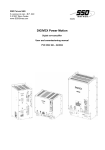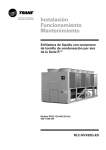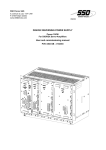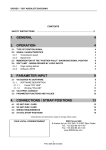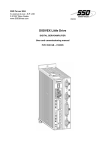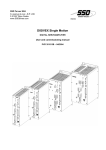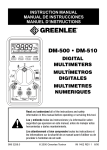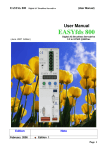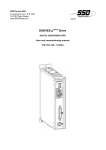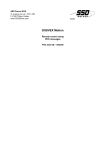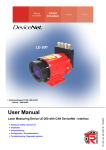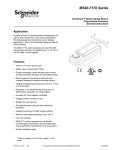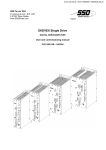Download 4.6 - X3 Terminal Connection
Transcript
RTS 40/80 Servoamplifier
CONTENTS
SAFETY INSTRUCTIONS
……………………………………………………………………………4
1.
- GENERAL
6
2.
- GENERAL CHARACTERISTICS
7
2.1
2.2
2.3
- Electrical Characteristics
- Mechanical Characteristics
- MIMIC DIAGRAM
7
8
8
3.
- DIMENSIONS
10
4.
- ELECTRICAL CONNECTIONS
12
4.1 - General Wiring Requirements
4.1.1
- Appliance handling
4.1.2
- Electromagnetic compatibility
4.2 - Wiring Diagram
4.3 - Front Panel
4.4 - X1 Terminal Connection
4.5 - X2 Terminal Connection
4.6 - X3 Terminal Connection
4.7 - X4 Terminal Connection
4.8 - Accessories
4.8.1
- Input mains filter:
4.8.2
- Transformers
4.8.3
- Inductors
5.
5.1
5.2
6.
6.1
6.2
6.3
6.4
6.5
12
12
12
13
16
17
19
19
19
20
20
20
20
- EXTERNAL SETTING DISPLAY
- Displays :
- Front Panel Settings:
24
24
24
- ADAPTATIONS
25
- Strap and Switch Positions
- Definitions
- Regulation Card
- Nominal Speed Adjustment (R105)
- Pulse current adjustment (R113)
25
26
26
27
28
1
PVD 3481 GB 01/2003
RTS 40/80 Servoamplifier
6.5.1
- Pulse current Ilim modification via R113
6.5.2
- Current limitation by external resistance or external voltage :
6.6 - I = f(t) Adjustment (R103 - R109)
6.6.1
- Trigger limit I = f(t) R103
6.6.2
- If(t) trigger delay (R109)
6.6.3
- Calculation of maximum duration of pulse regime
6.7 - Speed Information Adaptation (R104)
6.8 - Adaptation to the current limitation curve speed function If(N) (R131-R132)
6.9 - Adaptation to the U-RI function (R133-R134)
6.10
- Adaptation to max.N (R135)
6.11
- Adaptation to motor inductance (R136)
6.12
- Adaptation of dc voltage (RB)
6.12.1
- Effect of voltage adaptation on operating limits
6.12.2
-. Effect of voltage adaptation on recovery
7.
7.1
7.2
7.3
- SPEED LOOP
28
28
29
29
29
30
33
33
34
35
35
36
36
36
37
- Speed loop rapid adjustment
- Complete speed loop adjustment
- DIAGNOSTIC HELP
37
38
40
8.
- COMMISSIONING FAULTS
41
9.
- RAMP OPTION
43
10. - BATTERY OPERATED RTS 40/80 FEATURES
10.1
10.2
10.3
10.4
- Electrical Characteristics
- X3 Terminal Connection
- Adaptation to U-RI Function (R133, R134)
- Adaptation to dc voltage (RB)
44
44
44
44
44
11. - ADDITIONAL RESISTOR TYPE RTS 40/80 SPECIAL
FEATURES
48
11.1
11.2
11.3
11.4
- Description
- Dimensions
- Front Panel
- Wiring Diagram
48
48
50
51
2
PVD 3481 GB 01/2003
RTS 40/80 Servoamplifier
Characteristics and dimensions subject to change without notice.
YOUR LOCAL CORRESPONDENT
SSD Parvex SAS
8 Avenue du Lac / B.P 249 / F-21007 Dijon Cedex
Tél. : +33 (0)3 80 42 41 40 / Fax : +33 (0)3 80 42 41 23
www.SSDdrives.com
3
PVD 3481 GB 01/2003
RTS 40/80 Servoamplifier
SAFETY
Servodrives present two main types of hazard :
- Electrical hazard
Servoamplifiers may contain non-insulated live AC or DC
components. Users are advised to guard against access to live
parts before installing the equipment.
Even after the electrical panel is de-energized, voltages may be
present for more than a minute, until the power capacitors have
had time to discharge.
Specific features of the installation need to be studied to prevent
any accidental contact with live components :
- Connector lug protection ;
- Correctly fitted protection and earthing features ;
- Workplace insulation
(enclosure insulation humidity, etc.).
General recommendations :
• Check the bonding circuit;
• Lock the electrical cabinets;
• Use standardised equipment.
- Mechanical hazard
Servomotors can accelerate in milliseconds. Moving parts must be
screened off to prevent operators coming into contact with them.
The working procedure must allow the operator to keep well clear
of the danger area.
All assembly and commissioning work must be done by qualified
personnel who are familiar with the safety regulations (e.g. VDE
0105 or accreditation C18510).
4
PVD 3481 GB 01/2003
RTS 40/80 Servoamplifier
Upon delivery
All servoamplifiers are thoroughly inspected during manufacture and tested at length
before shipment.
•
•
Unpack the servoamplifier carefully and check it is in good condition.
Also check that data on the manufacturer's plate comries with data on the order
acknowledgement.
If equipment has been damaged during transport, the addressee must file a complaint with the
carrier by recorded delivery mail within 24 hours.
Caution :
The packaging may contain essential documents or accessories, in particular :
• User Manual,
• Connectors.
Storage
Until installed, the servoamplifier must be stored in a dry place safe from sudden
temperature changes so condensation cannot form.
Special instructions for setting up the equipment
CAUTION
For this equipment to work correctly and safely it must be
transported, stored, installed and assembled in accordance with
this manual and must receive thorough care and attention..
Failure to comply with these safety instructions may lead to
serious injury or damage.
The cards contain components that are sensitive to electrostatic
discharges. Before touching a card you must get rid of the static
electricity on your body. The simplest way to do this is to touch a
conductive object that is connected to earth (e.g. bare metal
parts of equipment cabinets or earth pins of plugs).
5
PVD 3481 GB 01/2003
RTS 40/80 Servoamplifier
1. - GENERAL
The RTS 40/80 servoamplifier is a four-quadrant speed controller designed to drive medium
power dc motors (up to 6500 W mechanical power). The output stage features IGBT type
technology and is galvanically isolated with a Hall effect current sensor. External inductors are
not required (except for AXEM motors) because of high frequency, inaudible (17 kHz) PWM
chopping. It is a single-axis controller (wall-mounted) with front panel connections.
Functions :
- tachometer or U-RI speed regulation
- current control
- current reduction with speed
- current reduction with temperature
- external current reduction
- zero speed adjustment
- zero torque adjustment
- Fault clearance
- analogue speed or torque information
- Controler status on relay contact
- ± 15 V available
- recovery limitation
- customisation card
- optional ramp card (internally mounted)
- clockwise and counter-clockwise stop feature
6
PVD 3481 GB 01/2003
RTS 40/80 Servoamplifier
2. - GENERAL CHARACTERISTICS
2.1 - Electrical Characteristics
Power supply: three-phase between 75 and 165 V ac maximum (For use of standard
transformers - 85, 100, 110, 135 & 150 V ac ±10%)
Output voltage: 200 V dc with 150 V ac power supply
Output current:
40 A nominal
80 A - 2 sec pulse (starting from I=0)
Recovery*:
Mean power max. 525 W max
Pulse power max. 13 000 W
Max. cycle 4%
Max. uninterrupted duration 2 sec
(*servoamplifier with 150 V ac supply)
Minimum inductance: 0.4 mH for a form factor of less than 1.002
(compulsory for AXEM motors)
Total dissipation: 300 W excluding recovery
Chopping frequency: 17khz
Power stage galvanically isolated
Speed range:
- tachometer regulation 1/10 000
- U-RI regulation 1/10
or U-RI / 100 with RR6606C
and RD6606B or 6607B
Static precision of typical speed for zero load at nominal current:
- tachometer regulation:
Nmax - Nmax/100
:
Nmax/100 - Nmax/1000
:
Nmax/1000 - Nmax/10 000 :
- U-RI regulation: ±20%
Speed bandwidth (depending on drive line): up to 150 Hz
Current regulation precision: ± 2% of nominal current at 25° C
Current loop linearity: ± 1% of nominal current at 25° C
7
PVD 3481 GB 01/2003
± 0.5%
± 1.5%
± 10%
RTS 40/80 Servoamplifier
2.2 - Mechanical Characteristics
Storage temperature:
-20° to +70° C
operating temperature: 0° to +40° C
from 40° to 60° C: -3.5% of nominal current per degree
Maximum altitude: 1000 m
above: -1% of nominal current per 100 m
Protection Index: IP 20
2.3 - MIMIC DIAGRAM
8
PVD 3481 GB 01/2003
RTS 40/80 Servoamplifier
9
PVD 3481 GB 01/2003
RTS 40/80 Servoamplifier
3. - DIMENSIONS
See the following page, drawing number
- FELX 305008
10
PVD 3481 GB 01/2003
RTS 40/80 Servoamplifier
11
PVD 3481 GB 01/2003
RTS 40/80 Servoamplifier
4. - ELECTRICAL CONNECTIONS
4.1 - General Wiring Requirements
4.1.1 - Appliance handling
See the safety instructions given at the beginning of this manual. In particular, wait for all the front
panel LEDs to go off completely before doing any work on the servo-amplifier or servomotor.
4.1.2 - Electromagnetic compatibility
EARTHING
•
•
Comply with all local safety regulations concerning earthing.
Utilize a metal surface as an earth reference plane (e.g. cabinet wall or assembly grid).
This conducting surface is termed the potential reference plate. All the equipment of an
electrical drive system is connected up to this potential reference plate by a low
impedance (or short distance) link. Ensure the connections provide good electrical
conduction by scraping off any surface paint and using fan washers. The drive will then
be earthed via a low impedance link between the potential reference plate and the earth
screw at the back of the RTS. If this link exceeds 30 cm, a flat braid should be used
instead of a conventional lead.
CONNECTIONS
• Do not run low-level cables ( inputs/outputs, NC or PC links) alongside what are termed
power cables (power supply or motor). Do not run the power supply cable and the motor
cables alongside one another otherwise mains filter attenuation will be lost. These
cables should be spaced at least 10 cm apart and should never cross, or only at rightangles.
• All low-level signals will be shielded with the shielding connected at both ends.
• The motor cables are limited to the minimum functional length. The yellow and green
motor cable lead must be connected to the box or front panel terminal block with the
shortest possible link.
• This usually means shielded motor cable is not required. Chokes may also be inserted
into the motor phase leads.
12
PVD 3481 GB 01/2003
RTS 40/80 Servoamplifier
MAINS FILTERING
The mains filter must be mounted as close as possible to the potential reference between the
mains and the TRS power supply. (p.20 FR 03036).
Avoid running cables together, ahead of and after the filter.
Filters sometimes have high leakage currents. In this case, comply with the standard connection
diagrams when fitting them.
OTHER MEASURES
Self-inducting components must be protected against interference: brakes, contactor or relay
coils, fans, electro-magnets, etc.
4.2 - Wiring Diagram
See the following page, drawing number
- FELX 305062 and FELX 305823
13
PVD 3481 GB 01/2003
RTS 40/80 Servoamplifier
14
PVD 3481 GB 01/2003
RTS 40/80 Servoamplifier
15
PVD 3481 GB 01/2003
RTS 40/80 Servoamplifier
4.3 - Front Panel
16
PVD 3481 GB 01/2003
RTS 40/80 Servoamplifier
4.4 - X1 Terminal Connection
Permissible cable cross-section: 1.5 mm2 multistrand
Use screened cables
N°
TERMINAL
————————
Designation
1
TACH +
The screened connected to earth terminals
Tacho differential inputs. Use shielded cable with
Input
shielding connected to terminal 3.
2
TACH -
Input
3
Input voltage must not exceed 100 V.
-
Tachometric cable shielding. Do not connect
shielding at tacho end.
4
REF +
Input
Speed or current differential reference depending
on position of selector switch S1.
5
REF -
Input
± 10 V corresponds to rated motor speed at speed
reference. Use shielded cable with shielding
connected to terminal 6.
6
7
IRED
Shielding, to be connected at numerical control
end also.
Input
Analogue current reduction. This reduction
can be driven either by voltage or by an
external resistor by connecting it to 0VA
(terminal 8).
External resistor value:
Percentage of maximum
servoamplifier current
Resistance R in kΩ
10
20
30
40
50
60
70
80
90
1.21
4.75
8.25
15
18.2
27.4
33.2
47.5
56.2
17
PVD 3481 GB 01/2003
RTS 40/80 Servoamplifier
Permissible cable cross-section: 1.5 mm2 multistrand
Use screened cables
N°
TERMINAL
————————
Designation
8
0 VA
-
9
SPEED OR
I OUT
Output
The screened connected to earth terminals
Internally connected to mechanical earth
Signal providing speed or current image depending on
selector switch S2 position.
± 10 V corresponds to the maximum the value.
Typical applications:
synchronisation of multiple conveyors, master-slave
mode, cutting tool wear surveillance
10
SPEED EN./
Input
SPEED ENABLE. For connection to 0 V (terminal 13).
Connected to 0 V (terminal 13) this input enables only
counter-clockwise movement viewed from shaft end
(corresponds to negative speed reference)
+LIM
(Y3 in position 2-3
on RR6606B)
Typical application:
Clockwise stroke limit
11
TORQUE EN.
Input
TORQUE ENABLE. For connection to 0 V (terminal 13)
to enable current to servomotor. If the terminal is not
connected, the servomotor turns freely.
When the servomotor is fitted with a holding brake, this
input control must be synchronised with the brake
control.
12
RESET/
Input
Reset. By connecting RESET to terminal 13 the fault
memory is cleared and the controller is ready again, if
the fault has disappeared. Switching the servoamplifier
off and then back on has the same effect as resetting.
Connected to 0 V (terminal 13) this input enables only
clockwise movement viewed from shaft end
(corresponds to positive speed reference)
-LIM
(Y3 in position 2-3
on RR6606B)
Typical application:
Counter-clockwise stroke limit
13
14
OVD
-
0V logic, for connection to terminals 10 and 11.
-
Logic link cable screening (terminals 10 and 11).
18
PVD 3481 GB 01/2003
RTS 40/80 Servoamplifier
4.5 - X2 Terminal Connection
N°
X2/1
X2/2
X2/3
X2/4
X2/5
TERMINAL
———————
Designation
+ 15 V
0V
- 15 V
READY
READY
Permissible cable cross-section: 1.5 mm2 multistrand
Output
Output
Output
Output
± 15 V power supply
25 mA ± 5%
available for external applications
Output via contact of sum of faults.
Contact opens if fault occurs and if power
supply absent
Permissible current: 0.5 A
Permissible voltage: 230 V
4.6 - X3 Terminal Connection
N°
X3/1
X3/2
X3/3
X3/4
TERMINAL
———————
Designation
U~
V~
W~
Permissible cable cross-section: 1.5 mm2
Input
Input
Input
-
U phase of three-phase power supply
V Phase.
W Phase.
Earth. For connection to the earthing bar of
the appliance cabinet. With cable crosssection: 2.5 mm2 min.
4.7 - X4 Terminal Connection
N°
X4/1
X4/2
X4/3
TERMINAL
———————
Designation
MM+
Permissible cable cross-section: 1.5 mm2
Output
Output
-
Connection
Servomotor.
Earth. For connection to the motor frame.
19
PVD 3481 GB 01/2003
RTS 40/80 Servoamplifier
4.8 - Accessories
4.8.1 - Input mains filter:
Dimensions as in drawings FELX 304967 (see following page).
4.8.2 - Transformers
Dimensions as in drawings FELX 302570 (see following page).
4.8.3 - Inductors
These are compulsory with AXEM motors and motors whose winding inductance is less then the
operating minimum (recommended inductance: SF 02024).
Dimensions as in drawings FELX 302804 (see following page).
20
PVD 3481 GB 01/2003
RTS 40/80 Servoamplifier
21
PVD 3481 GB 01/2003
RTS 40/80 Servoamplifier
22
PVD 3481 GB 01/2003
RTS 40/80 Servoamplifier
23
PVD 3481 GB 01/2003
RTS 40/80 Servoamplifier
5. - EXTERNAL SETTING DISPLAY
5.1 - Displays :
POWER ON
RECOVERY
off
: no power supply to drive
On
: drive OK
Flashing
: drive fault
recovery control
Controller faults are distinguished and displayed by miniature LED strips on the front panel :
I=F(t)
OVERCURRENT
OVERVOLTAGE
UNDERVOLTAGE
OVERTEMP
TACH. FAULT
excessive mean motor current
motor short circuit or current too high
bus voltage too high
bus voltage too low
excessive temperature
tachometer cut-out or reversal, overspeed
5.2 - Front Panel Settings:
GAIN
: speed loop gain adjustment
SPEED ADJ
: fine adjustment of maximum speed
SPEED OFFSET
: fine adjustment of speed offset
For current control operation, capacitor C101 must be removed to give the broadest bandwidth
with resistor R136 adapted to load inductance.
24
PVD 3481 GB 01/2003
RTS 40/80 Servoamplifier
6. - ADAPTATIONS
ATTENTION
As the servoamplifiers settings are done at the factory, the information on this page is not
essential.
6.1 - Strap and Switch Positions
- Control mode: S1 switch
speed control
current control
S1
1
O
- Current or speed (N or I) information output (solder tag or S2 switch)
current information
speed information
S2
1
0
±10 V output available at X1/9.
10 V = Imax
10V = nominal speed
- Tachometer or U-RI regulation (solder tag or S3 switch)
tachometer
U-RI
S3
1
0
- Selection of +LIM, -LIM function
The +LIM, -LIM function is selected with strap Y3 (solder tag on RR6606B or RR6606C card).
When the strap is in position 2-3, the SPEED ENABLE input (+LIM) (X1-10) is used to enable or
disable clockwise motor rotation viewed from the shaft end. Rotation is enabled when X1-10 is
connected to the 0 V (terminal 13 of X1).
Likewise, the RESET input (-LIM) (X1-12) is used to enable or disable counter-clockwise rotation
of the motor. Rotation is enabled when X1-12 is connected to the 0 V (terminal 13 of X1).
N.B. Y5 and Y6 must be in the ON position.
25
PVD 3481 GB 01/2003
RTS 40/80 Servoamplifier
6.2 - Definitions
Nn
Ilim
Imax
Io
Ket
Ke
r
L
Ub
Val
=
=
=
=
=
=
=
=
=
=
rated speed of application for 10 V reference speed
maximum pulse current of motor
maximum pulse current of servo amplifier
permanent motor current
speed information gradient in volts for 1000 rpm
back electromotive force of motor in volts per 1000 rpm
resistance of motor and its supply circuitry in ohms
inductance of motor in Henrys
bus voltage in volts (1.35 x Vin AC)
transformer phase-phase output voltage in Volts rms
6.3 - Regulation Card
26
PVD 3481 GB 01/2003
RTS 40/80 Servoamplifier
6.4 - Nominal Speed Adjustment (R105)
- standardised value close to the calculated value and adjustable with potentiometer SPEED
ADJUST :
R105 =
192000
Nn
in
en kΩ
Nn: speed for set point of 10 V in rpm
Speed Nn in rpm
700
770
869
950
1055
1200
1280
1400
1590
1650
1750
1800
1920
2100
2330
2600
2820
3100
3420
3700
4040
4400
4900
5200
R105 in kΩ
275
-----------221
-----------182
-----------150
-----------121
-----------110
-----------100
-----------82,5
-----------68,1
-----------56,2
-----------47,5
-----------39,2
------------
The equipment may be adapted for speeds lower than those shown above but this hinders servo
amplifier performance with regard to drift and gain. The maximum value not to be exceeded for
R105 is 4.75 MΩ.
27
PVD 3481 GB 01/2003
RTS 40/80 Servoamplifier
6.5 - Pulse current adjustment (R113)
6.5.1 - Pulse current Ilim modification via R113
RTS 40/80-200
R113 =
I lim
in kΩ
24 − 0,3I lim
Ilim
in %
Imax
10
20
30
40
50
60
70
80
90
R113 in kΩ
0,392
0,825
1,5
2,21
3,32
4,75
7,5
12,1
33,2
6.5.2 - Current limitation by external resistance or external voltage :
- by external resistance :
RTS 40/80-200
Ielim in amps
Rext =
Ie lim
in kΩ
Ie lim
2,68 −
47,5
Ielim
in %
Imax
10
20
30
40
50
60
70
80
90
Rext in kΩ
3,32
6,81
10
15
22,1
27,4
39,2
47,5
56,2
- by external voltage :
linear from 0 V to 10 V, with 10 V = Imax
28
PVD 3481 GB 01/2003
RTS 40/80 Servoamplifier
6.6 - I = f(t) Adjustment (R103 - R109)
6.6.1 - Trigger limit I = f(t) R103
R103 adjusts the triggering threshold enabled by the drive with mean current Io.
Io is generally the rated motor current.
RTS 40/80-200
Io in amps
R103 =
10
Imaxi
−2
Io
in kΩ
Io = rated motor current.
Imax = drive pulse current (80 A)
Io
in %
Imax 2
20
30
40
50
60
70
80
90
R103 in kΩ
1,5
2,21
3,32
4,99
7,5
12,1
20
43,2
6.6.2 - If(t) trigger delay (R109)
R109 modifies the time constant for triggering in If(t).
- One second to Ilim from I = 0
Io
in %
Ilim
R109 in kΩ
20
30
40
50
60
70
80
2740
1210
825
562
392
274
150
- Two seconds to Ilim from I = 0
Io
in %
Ilim
R109 in kΩ
20
30
40
50
60
70
80
10000
3320
1820
1210
825
562
274
Operating times of more than 2 sec can be considered provided that the R103 and R113 values
determining Io and Ilim are adjusted.
29
PVD 3481 GB 01/2003
RTS 40/80 Servoamplifier
Example :
R109 = 562 kΩ
Io
in %
Ilim
t in s
20
30
40
50
60
70
80
0,3
0,5
0,7
1
1,4
2
3,5
20
30
40
50
60
70
80
0,6
1
1,4
2
2,7
3,8
6,8
R109 = 1210 kΩ
Io
in %
Ilim
t in s
The maximum value of resistor R109 is 1.21 MΩ (2 x Io for 2 seconds) when R103 is infinite (the
trigger current in If(t) corresponds to the permanent current of the controller). For permanent
currents lower than that of the controller, R109 may be greater than 1.21 MΩ. See the calculations
based on expressions of R109.
6.6.3 - Calculation of maximum duration of pulse regime
Based on the typical operating cycle below.
I
Ilim
Iu
t
T
t
30
PVD 3481 GB 01/2003
RTS 40/80 Servoamplifier
Ilim
: pulse current set by R113
Iu
: mean current in permanent use
Io
: nominal current set by R103
t
: pulse current duration
T
: repetition period
Iu
Io of the mean current at established speed over the permanent current set by
Io
Io
R103, plot this value on the y-axis of the graph. Depending on the possible
ratio, given by
Ilim
From the ratio
R103 and R113, read on the x-axis the duration t of the pulse current that does not trigger If(t).
The minimum repetition period T can also be read from the x-axis.
These values depend on the choice of resistor R109.
The graph is plotted for R109 = 562 kΩ.
For other values of R109 apply the correction factor
R109
to t and T readings.
562
31
PVD 3481 GB 01/2003
RTS 40/80 Servoamplifier
Network Io: I1 (%)
Iu/Io (%)
Réseau Io:Il (%)
100
50
20
0
0
0.2
1.54
30
40
50
60
70
80
0.4
0.6
0.8
1
1.2
1.4
1.6
1.67
1.76 1.90
2
2.14
2.26 2.39
1.8
2
2.53
2.66
2.2
2.4
2.82 2.96
t(s)
2.6
T(s)
Example of a motor with a 15/30 controller whose R103 is installed for a permanent current of
10 A. It is used for
Iu
4
= 40% ) with pulse current limited by R113 to:
established current of 4 A ( =
Io 10
a : 2Io : 20 A
Io
= 50%
Ilim
b : 3Io : 30 A
Io
= 33%
Ilim
The authorised duration of the pulse current will be:
a : t # 0,7 s
b : t # 0,4 s.
32
PVD 3481 GB 01/2003
RTS 40/80 Servoamplifier
6.7 - Speed Information Adaptation (R104)
The R104 resistor is used to adapt the tachometer generator gradient to that of the controller
(2V/1000 rpm)
100
in kΩ
Ket
−1
2
Ket: electromotive force of the tachometer generator in volts per 1000 rpm
R104 =
Ket in V/tr/mn
R104 in kΩ
2
∞
3
200
4
100
5
68
6
51
8
33
10
24
12
20
15
15
20
11
To obtain a gradient of 1V / 1000 rpm, short circuit the solder tags Y1 and Y2 with R104 = ∞.
CAUTION : Do not exceed 100V on the tachometer input.
6.8 - Adaptation to the current limitation curve speed
function If(N) (R131-R132)
Resistor R131 is used to select the zero current point on the speed current diagram.
Resistor R132 determines the speed beyond which pulse current (selected by R113) begins to
decrease linearly with speed.
When function I = F(n) is not required :
R131 = 10 K
R132 = 100 K
I
Ilim
Nr
Ns N
Nr : speed in thousands of rpm above which current decreases
Ns : speed in thousands of rpm at which current is zero.
33
PVD 3481 GB 01/2003
RTS 40/80 Servoamplifier
R131 =
83000
in kΩ
Ns
500
162
4500
18,2
Ns in tr/mn
R131 in kΩ
Ns in tr/mn
R131 in kΩ
1000
82,5
5000
16,2
1500
56,2
5500
15
RTS 40/80-200
Ilim in amps.
2000
39,2
6000
13,7
R132 =
R132 in
KΩ
Ns - Nr
500
1000
1500
2000
2500
3000
3500
4000
20
27,4
12,1
8,25
6,81
5,62
4,75
3,32
3,32
2500
33,3
6500
3000
27,4
7000
4000
20
700I lim+ 2220
in kΩ
Ns − Nr
Ilim
in %
Imax
60
100
33,2
22,1
18,2
15
10
10
8,25
40
47,5
22,1
16,2
12,1
10
6,82
6,82
5,62
3500
22,1
80
82,5
47,5
33,2
22,1
18,2
15
13,7
12,1
100
121
56,2
39,2
27,4
22,1
18,2
16,2
15
6.9 - Adaptation to the U-RI function (R133-R134)
This adaptation is necessary even when operating with tachometer generation to supervise
tachometer failure.
R133 is used to adjust the gain depending on the motor back emf :
For standard power supply transformers:
4Ub
38Kb
R133 in kΩ =
or
(with RD6606B or RD6607B)
Ke
Ke
RTS 40/80-200
R133 =
Ub : controller bus dc voltage in volts
Ke : motor emf in volts / 1000 rpm
Kb: bus voltage reduction ratio
760
in kΩ
Ke
(20 for RD6606B)
(7.4 for RD6607B)
34
PVD 3481 GB 01/2003
RTS 40/80 Servoamplifier
R134 is used to adapt the motor resistor to its power supply circuit (brushes - cables)
15000 × r
1500r
or
(with RD6606B or RD6607B)
Kb
Ub
Ub : controller bus dc voltage in volts
r : motor and supply circuit resistance in ohms
R134 in kΩ =
For standard power supply transformers (Ub = 190 V):
RTS 40/80-200
R134 = 75 r
in kΩ
6.10 - Adaptation to max.N (R135)
Resistor R135 determines the tripping limit of maximum speed for tachometric servo control and
U-RI operation.
10Nn
7500 − Nn
Nn: speed for 10 V set point in rpm
R135 in kΩ =
Nn in tr/mn
R135 in kΩ
Nn in tr/mn
R135 in kΩ
1000
1,5
4000
12,1
1500
2,74
4500
15
2000
3,92
5000
22,1
2500
4,75
5500
27,4
3000
6,81
6000
39,2
3500
8,25
6.11 - Adaptation to motor inductance (R136)
Resistor R136 adapts the courrent loop gain to the load inductance.
2.10 4 L
Ub
Ub : controller bus dc voltage in volts
L : motor inductance and any additional inductance in mH
R136 In kΩ =
Resistor R136 adapts current loop gain to load inductance. When selecting R136 take the
closest value in the following range and its multiples :
10 - 12 - 15 - 18 - 22 - 27 - 33 - 39 - 47 - 56 - 68 - 75 - 82 - 100
35
PVD 3481 GB 01/2003
RTS 40/80 Servoamplifier
6.12 - Adaptation of dc voltage (RB)
Resistor RB is used to adapt limit values : MAX U, MIN U, tripping of supply voltage recovery.
RB =
RTS 40/80-200
100
in kΩ
150
−1
Val
Val : transformer phase-phase output voltage in Volts rms.
R136 dependent on voltage Ub must be readapted.
Resistors R133, R134 are to be re-adapted for RD6606 and RD6607 only.
POWER SUPPLY
85 VAC
100 VAC
110 VAC
135 VAC
150 VAC
RB
121kΩ
200kΩ
274kΩ
-
6.12.1 - Effect of voltage adaptation on operating limits
Vrms
value
150
135
110
100
85
Ub
in V
200
190
145
135
110
MaxU
in V
258
258
189
172
141
MinU
in V
120
120
88
80
66
Recovery
Dec in V Rel in V
243
230
243
230
178
168
162
153
133
126
6.12.2 -. Effect of voltage adaptation on recovery
Vrms value
150
140
110
100
85
Mean power in W
525
525
280
230
160
36
PVD 3481 GB 01/2003
Pulse power in W
13000
13000
7000
5800
4000
RTS 40/80 Servoamplifier
7. - SPEED LOOP
7.1 - Speed loop rapid adjustment
* Offset adjustment
Once ambient temperature is stabilised, adjust zero speed to
the mid-position with the "SPEED OFFSET" potentiometer
on the front panel.
* Speed adjustment
The "SPEED ADJUST" potentiometer
calibration of speed for a given reference.
produces
fine
* Gain adjustment
By increasing gain, the servo motor becomes more rigid.
Turn the "GAIN" potentiometer clockwise until the motor is
unstable and vibrates.
Then turn the potentiometer back one or two turns. If there is
a large load on the potentiometer, the potentiometer
adjustment range may be inadequate and resistance R101
will have to be increased.
Application : Potentiometer reference
± 10 V REFERENCE CONNECTION
NON
5
5
4
4
6
6
OUI
P
..
R1
R2
+ 15 VDC
0V
1
Terminal block X2
Bornier X2
2
- 15 VDC 3
Inputs not connected
5
PLC/CN
5
4
6
5
4
6
RTS 1
RTS 2
PLC/CN
5
4
6
5
4
6
RTS 1
4
(1)
Terminal
Bornier X1 block X1
6
RTS 2
Blindage
8
YES
NO
Shielding not connected at numerical control end
The connecting cable by shielded twisted pair for the tacho and reference is available as an option.
(1) Terminal 4 may be connected to terminal 8
Example : ± 10 V
P = 10 kΩ linear
potentiometer
R1 - R2 = 1.8 kΩ, 1/2 W
resistor
37
PVD 3481 GB 01/2003
RTS 40/80 Servoamplifier
7.2 - Complete speed loop adjustment
Systematically applicable when J charge ≥ 10 J motors
Caution As servo amplifiers are factory set based on
parametersprovided by the customer, this setting does
not usuallyrequire adjustment.
Before adjusting the speed loop, all the adjustable
parameters must be fixed (current limits, speed scale
setting, speed limits). Adjusting the speed scale setting
alters loop gain and means readjustments are required.
C103
C101
Equipment required
R108
R101
- Storage oscilloscope (digital if possible), easy to trip.
- Manual speed reference generator (battery box) or low
frequency generator with series capacitor to produce
zero mean speed (out and return about a position).
- Decade box for capacitor and resistor adjustment.
Reference battery box, with oscillator for automatic
control is available as an option.
Gain
Servoamplificateur
Speed amp
Réf.EE1- Ref.
INVERSEUR
INVERTER
-
10K
15
Method
+
10 K
9V
batterie
battery
9V
FIG 1
Adjust the gain potentiometer to the centre (so gain may
Réf.EE1++ be varied up or down after adjustment).
Ref.
Fit a large integration capacitor C101 - 10µF or strap.
4
Adjust proportional gain starting by R101 = 10 kΩ.
14
5
Speed recorded
between N measurement
prise entre
andVitesse
0 V analogue
overshoot : +10%
mesure N et 0V ana.
dépassement : + 10 %
c
b
a
< 100 Hz
Time
Temps
Increase R101 until 10% overshoot on speed reference
increment. Always use small speed reference increments
(e.g. ± 100 rpm or less) so the system remains linear. For
large increments, current limitation (= torque limitation)
masks the real situation and reduces overshoot.
The adjustment obtained with high speed increments
would be incorrect.
In many cases, it is not possible to increase gain to
produce overshoot especially for high inertia systems.
FIG 1 : a, b, c - graphs obtained with
increasing R101 values
38
PVD 3481 GB 01/2003
RTS 40/80 Servoamplifier
FIG 2
a
b
c
100 -à300
300Hz
Hz
Time
Temps
FIG. 2 : a, b, c, - graphs obtained with
increasing C103 values
In some cases, gain limitation is due to resonance: the
motor starts to whistle or vibrate at high frequencies (>
100 Hz). A -1 filter must be included at a frequency 3 to 4
times lower than the oscillation so the gain can be
increased by the same ratio. This can be done by
connecting a C103 capacitor in parallel with the R101
proportional gain resistor, and increasing the capacitor
until the whistling stops (usually several tens of nF) and
then continuing to increase gain while monitoring
overshoot and torque ripple. The C103 10 nF capacitor is
ready fitted as standard in parallel with the R101 gain
resistor.
FIG 3
Vitesse
Speed
c
20%
overshoot20 %
Dépassement
b
When the gain is set, the C101 integration capacitor must
be reduced to produce 15 - 20% overshoot (still for small
speed increments).
a
Time
Temps
FIG 3 : a, b, c - graphs obtained with
decreasing C101 values
39
PVD 3481 GB 01/2003
RTS 40/80 Servoamplifier
7.3 - DIAGNOSTIC HELP
ENERGISING
« POWER ON » on
"POWER ON" off
"POWER ON" flashes
Check which LED on front
panel
Measure voltage at terminals U, V,
W
Voltage
present
Check fuse
F1 (gauge 5
x 20)
Motor races and "TAC" LED lights up
No
voltage
Check fuses, main
switch and
transformer
connections
Check tachometric dynamo wiring, invert
tacho wires if fault arises during first time
use. Motor under current control: selector
S1 must be changed.
Motor fails to rotate
Check motor wiring and fuses. If the dI/dT
LED is on, check the motor is not shortcircuited and there is no ground fault.
"CT" (temperature) LED is on
Check the ventilation system is working
correctly. Ambient temperature of the
electrical cabinet must be less than 40°C.
The motor is unstable and vibrates
Check the motor and servo amplifier are grounded
(mandatory).
Check the speed reference is stable (with oscilloscope)
and ±15 V voltages if necessary.
Check the customisation components correspond to
the motor.
Reduce gain using the front panel
potentiometer : turn invers clockwise
No effect
Motor drifts
Adjust zero speed with the "SPEED OFFSET"
potentiometer
Incorrect speed
Adjust speed with "SPEED OFFSET"
potentiometer
Check :
• terminals X1/10 and X1/11 must be connected to 0V
• selector S1 must be in correct position
• reference voltage is present
Motor fails to rotate
40
PVD 3481 GB 01/2003
RTS 40/80 Servoamplifier
8. - COMMISSIONING FAULTS
a - check the connections to the following components:
transformer, relays, motor and any additional inductors, tachometer, controls.
b - with the speed and current (X1/10 and X1/11 not connected), connect the power to the
controller. The "POWER ON" LED should light (if not check the transformer wiring and
relays). If the "POWER ON" LED flashes, measure the transformer secondary voltage.
Adjust the output voltage if necessary with the ±5% terminals. The motor then turns freely
by hand.
c - Zero speed set point (X1/4 = X1/5 = 0 V), release the controller (X1/10 and X1/11 to 0 V) the
motor must be under torque. If the motor races, cut the power and check the signals from
the tachometer (cut-out or reversal) before switching on again ("RES" and/or "TAC" fault).
If the motor howls or vibrates (possibly with "IFT" fault) reduce the controller gain with the
front panel potentiometer. If the controller had switched to fault mode ("POWER ON"
flashing), clear the fault by resetting (X1/12 to 0 V).
d - Gradually increase the controller set point and observe motor acceleration. Check the motor
rotates in the opposite direction when the set point is reversed. If a fault arises on reversal
for a 10 V set point, adjust the controller gain (see paragraph e). If the fault persists, wire
the power transformer secondary to the -5% terminals ("MAU" fault on LED strip).
e - Adjust the front panel settings if necessary
- SPEED offset: zero speed at zero set point (adjust when warm)
- SPEED adj: fine adjustment of speed for 10 V set point
- GAIN: turn clockwise to find the point of "instability" of the motor and its load (adjustment
may vary
with load inertia and elasticity), then move back by one or two revolutions.
- The point of "instability" may or may not be reached depending on the motor load. The
adjustment range can be shifted by increasing resistor R101.
41
PVD 3481 GB 01/2003
RTS 40/80 Servoamplifier
COMMISSIONING FAULTS:
TACH FAULT:
overspeed, speed signal reversed or cut out
OVER TEMP.:
excessive dissipater temperature
UNDER VOLTAGE:
AC supply voltage too low
unsuitable transformer
OVER VOLTAGE:
excessive energy return from load
excessive AC supply voltage
insufficient controller gain
OVER CURRENT:
defective motor wiring
AXEM motor wired up without additional inductor
IF(t):
excessive controller gain
over-restrictive operating cycle
NO DISPLAY ON "POWER ON" AND FAULT DIODES:
- transformer wiring - protective fuse
- RTS internal fuse
42
PVD 3481 GB 01/2003
RTS 40/80 Servoamplifier
9. - RAMP OPTION
The RG6602 ramp card slots into the RR6606 regulation card (Y5 must be in the off position:
solder tag removed). The ramp time value is adjustable by direction of rotation with
potentiometers R1 and R2. The time can be adjusted from 0.6 sec to 6 sec for a set point of 10
V. Time is increased by turning the potentiometers clockwise.
Slopes A and B can be adjusted separately.
Slope A = potentiometer R2
Slope B = potentiometer R1
Setpoint
Slope A
Slope B
Slope B
43
PVD 3481 GB 01/2003
Slope A
RTS 40/80 Servoamplifier
10. - BATTERY OPERATED RTS 40/80
FEATURES
10.1 - Electrical Characteristics
- Power supply
- Output voltage
- Recovery
- Minimum inductance
- Total dissipation
Battery voltage 17 - 90 V
Ubatt - 2 V
None
0.2 mH
70 W
10.2 - X3 Terminal Connection
- X3/1: Battery - X3/2: Battery +
- X3/3: Earth, to be connected to earth bar
10.3 - Adaptation to U-RI Function (R133, R134)
Use Ub voltage equals voltage battery, depending on the, in the formulas for calculating these
Ub
280
two resistances.
R133 = 4
or
with RD6607B
Ke
Ke
R134 =
15000 .r
or 203r with RD6607B
Ub
10.4 - Adaptation to dc voltage (RB)
voltage battery
V
24
36
48
72
resistance RB
KΩ
56,2
150
274
no RB resistance
Umin
V
16
27
31
43
44
PVD 3481 GB 01/2003
Umax
V
33
58
68
93
RTS 40/80 Servoamplifier
45
PVD 3481 GB 01/2003
RTS 40/80 Servoamplifier
46
PVD 3481 GB 01/2003
RTS 40/80 Servoamplifier
47
PVD 3481 GB 01/2003
RTS 40/80 Servoamplifier
11. - ADDITIONAL RESISTOR TYPE RTS
40/80 SPECIAL FEATURES
11.1 - Description
The additional resistor type RTS 40/80 drive has an extra terminal block X5 for connecting the
external resistor.
• The sales reference is: RTS 73204R8R
• The minimum value of resistor that can be connected is 4.5 Ω. The resistor must have a high
pulse capacity: greater than 25 times 500 W for 2 seconds (25 kJ).
• The 9 Ω RE69004 resistor that can be used must be fan-cooled.
Caution :
Connections to X5 terminals 1 and 2 must be insulated and made with conductors
of suitable cross-section (1 mm2).
Any short-circuit between them or with the casing or other conductors may
permanently damage the drive.
11.2 - Dimensions
48
PVD 3481 GB 01/2003
RTS 40/80 Servoamplifier
49
PVD 3481 GB 01/2003
RTS 40/80 Servoamplifier
11.3 - Front Panel
50
PVD 3481 GB 01/2003
RTS 40/80 Servoamplifier
11.4 - Wiring Diagram
51
PVD 3481 GB 01/2003





















































